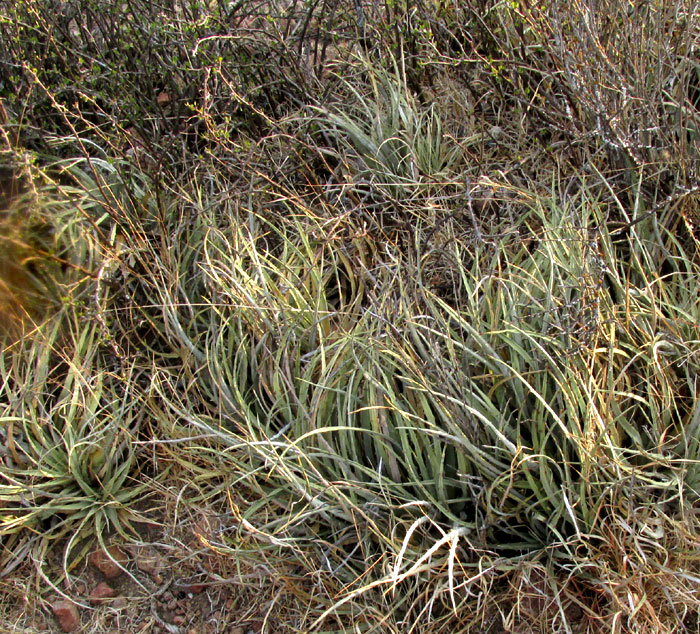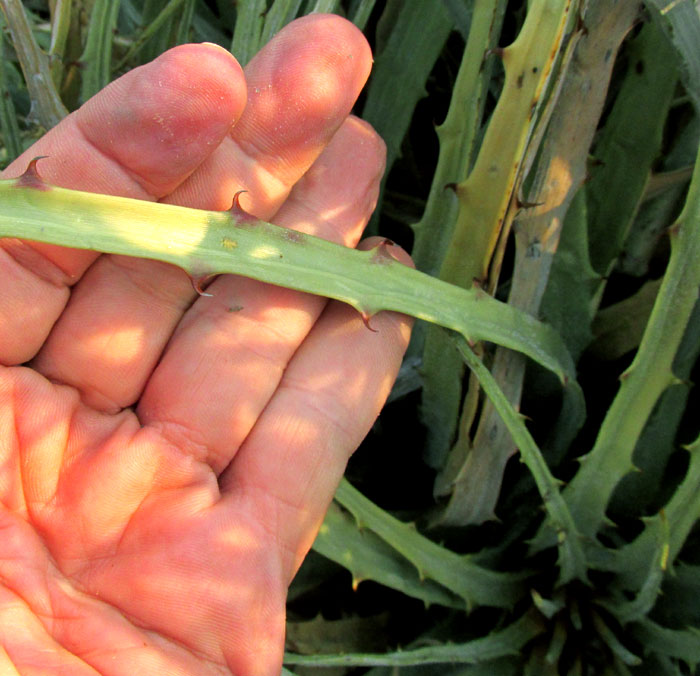Excerpts from Jim Conrad's
Naturalist Newsletter
entry dated May 19, 2022, notes from a camping trip among hills about 7kms ENE of Tequisquiapan, Querétaro state, MÉXICO
elevation about 2040m (6700 ft), near N20.57°, W99.85°
LECHUGUILLA

At the hot, dusty, glaringly sunny end of the dry season, the landscape here is mostly brown and gray, and anything showing a little greenness often is spiny. That's the case with the droughty patch of Lechuguilla shown above, and even that's more gray than green. What's shown in the picture probably is just one plant with many sprouts, or clones, because in this species sprouting is the main means of reproduction.
The name Lechuguilla is Spanish, but it's used by English speakers in the US Southwest. Even the technical binomial uses it: AGAVE LECHUGUILLA.
Lechuguilla occurs from western Texas and southern New Mexico south through arid and semiarid parts of Mexico, to central upland Mexico. It's one of the main plants of the vast Chihuahuan Desert, an "indicator species" for that desert. The population in the above photo doesn't look much like Lechuguilla plants grown in pots and in gardens, which usually are better watered. But they do look like the ones normally seen in the desert: mostly shorter than knee high, all clumped together, twisted mostly to one side, the blades much thinner than on garden plants. The drought doesn't much affect the spines' appearance though:

Back when I backpacked a good bit in the Chihuahuan Desert, very quickly I learned to respect Lechuguilla's spines. Notice how they're curved downwards. If you're an animal wanting to nibble on the plant's soft core, maybe you can get your snout into the plant, but when you try to remove your head, those spines dig in, tearing you apart. You remember that, maybe, and don't try to eating Lechuguilla again.
Still, Lechuguilla makes up a big part of the diet of the Collared Peccary. My impression has been that the blades aren't really eaten, but chewed for the juice, until there's nothing left but fiber, and that's left on the ground. Still, I can't imagine how a peccary chews a Lechuguilla blade. Not only does Lechuguilla bear spines along the margins, but also there are hard, very sharp, leg-stabbing ones at the tip.
I've read that, though Lechuguilla blades are toxic for livestock, deer eat the flower-stalks, and birds eat the seeds. In the old day, indigenous Americans roasted Lechuguilla stalks for food, and some Mexicans still make soap from its roots, and twine and rope from its fibers.
Lechuguilla may be super-abundant in the vast Chihuahuan Desert, but here in Querétaro state we're a good bit south of there. In Querétaro so far I've only seen Lechuguilla in this small spot in this single valley. Maybe this is a relict population left after a climate shift, or maybe in the past people brought plants here, knowing how useful they could be. Or maybe it's an advance population as the northern deserts expand southward during climate change.